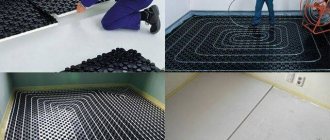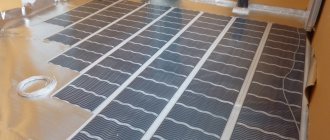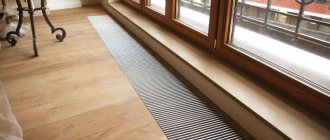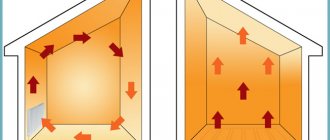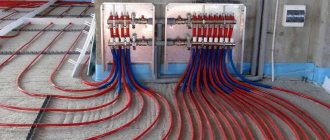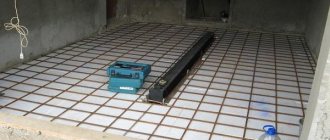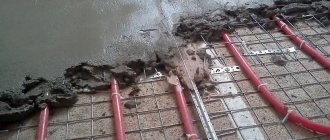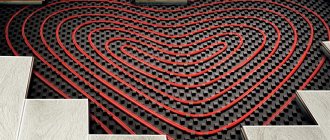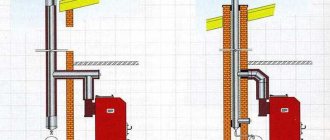Among owners of private houses, warm floors are becoming more and more popular every year. They can be either the main or additional source of heating the room.
When choosing a heated floor model for an apartment, everything is more or less clear - preference is given to electric types, since the water structure is heavy and requires connection to the central heating of an apartment building.
Choosing a heating system for a private home is more difficult, because any device can be installed. And before giving preference to any model, it is important to correctly weigh the pros and cons.
What is the difference between a water floor and an electric one?
To compare underfloor heating, and to determine whether it is better to install electric or water heating in your home, you need to take into account the characteristics of each type. After all, both devices are capable of providing a comfortable atmosphere in the room - uniform heating of the air.
As mentioned above, heated floors can be water or electric; their main difference is in the coolant.
Water heated floor
It is a structure made of pipes laid according to a certain pattern (“snail” or “spiral”) through which heated water or other coolant moves. To heat it, you need to connect to central heating, or to an individual boiler, which is equipped with a pump.
Hydrofloors evenly warm up the area, preventing the formation of cold zones. Can be installed in a screed or on a wooden floor. In the “pie”, the presence of a waterproofing layer and insulation is mandatory. The pipes are attached to the reinforcing mesh, or placed on a polystyrene foam mat with bosses.
Electric heated floor
Electric floors are powered by electricity, and there are:
- cable - the heating element is a heating cable with current-carrying conductors having high resistance;
- mats - also of the cable type, but the installation process is much simpler, since the wire is already fixed to the fiberglass mesh with a certain pitch;
- film infrared - this is a film with carbon plates, heat is released in the form of infrared waves.
Electric cable heated floors are placed in a layer of tile adhesive or in a concrete screed. Although a “dry” installation method is also possible. A layer of hydro and thermal insulation is required.
Infrared systems are characterized by simpler installation - without pouring a screed. Therefore, it is clear that among electric floors this is the best option for DIY construction in a private home, since the process is simple and quick.
Today, in cottages it is recommended to install a combined electric-water system. This heated floor is also called liquid electric, since the coolant liquid is not water, but antifreeze.
It is a circuit of pipes within which antifreeze circulates and a special wire is placed. When connected, the heating cable warms up the liquid, which in turn transfers heat to the flooring.
Capillary warm electric floor
Capillary water electric floors operate on a different principle. Their mechanics are based on high-speed pumping of a small amount of coolant through the heating circuit. The engineering solution looks like this:
- heating cable and other devices connected to the power grid inside the floor are missing;
- the heating circuit is laid from a tube of complex cross-section with a small clearance for the coolant passage;
- The system is powered from the central unit, where a miniature induction-diaphragm pump is located.
When the system is turned on, high-speed pumping of the coolant inside the circuit begins. The latter is assembled quite simply. Special tubes and sealing couplings are used. Since the speed of the coolant is high, heating equipment is not required to set records.
The specific characteristics of the main heater determine the criterion for choosing the coolant. The capillary floor uses only distilled water with stable electrical resistance and thermal expansion coefficient. It does not contain salts or foreign particles, which is important when circulating in a small-lumen circuit.
A central control unit with a power of 2-2.4 kW can cope with the task of heating a room with an area of up to 20 square meters. It does not require a separate connection line, but such equipment is still switched through its own circuit breaker and safety unit.
The capillary floor cannot be considered as a reliable main source of heat in the apartment. Although you can install a separate heating unit in each room, the overall energy output may not be sufficient. If residential premises lose a lot of heat, the volume of capillary tubes may not be enough to pump the required volume of coolant to ensure a comfortable air temperature.
Capillary heated floor
Advantages and disadvantages
When choosing the best heated floor model for your home, you should compare all the positive and negative aspects of each system.
Do-it-yourself apartment renovation. Comparison of heated floors.
Water heated floor
The main advantage of water heated floors compared to electric ones, especially when installed in a private wooden house, is fire safety. Also, it is worth noting that hydrofloors are suitable for installation in rooms of any humidity: baths, swimming pools, bathrooms.
The disadvantages of this type include more complex installation. It is not easy to do the installation yourself without having construction experience.
In addition, since pipes are mainly laid under a concrete screed, if the pipeline is damaged, it is very difficult to determine the location of the leak and troubleshoot the problem.
The thickness of the floor “pie” plays an important role in rooms with low ceilings; in a water structure it is impressive.
In order for the floor to function fully, the pipe laying step must be correctly calculated. A large step reduces efficiency, a small step overheats the surface.
Difficulty arises when choosing the power of the pump, as well as its correct installation. If the power is not selected correctly, then during its operation the total pressure in the system may decrease.
Important! On the one hand, the presence of high temperature in a water floor means better heating of the room, but on the other hand, it lowers air humidity, which is not very good for human health.
Another important point that complicates the process of installing a water floor when connecting to central heating is obtaining permission to carry out this work.
Electric heated floors
The main advantages of installing an electrical circuit in a private home:
- easy installation - no special equipment required;
- temperature control is available in a separate room;
- in the event of a breakdown, there is no need to dismantle the entire screed, it is enough to clear the place of the fault;
- in the case of mats or film, if a malfunction occurs in some area, then the entire structure continues to function;
- increased reliability.
In addition, certain models of this type of floor (IR film) can be used as a mobile heater, which is very convenient when using the device as an additional heating source.
It is worth noting that electric systems, unlike water ones, have a smaller “pie” thickness. They may be laid in a layer of tile adhesive, and IR film directly under the floor covering.
The main disadvantage of electric floors is the high cost of electricity. In addition, there is a risk in terms of fire safety, although it is minimal. Do not forget about the problems in the absence of electrical energy, the work of the floor depends on it.
As for mats and film floors, if they are present under the flooring, it becomes difficult to arrange furniture, since heavy objects cannot be installed on them. It is necessary to first think through the interior and the layout of the heating elements.
Installation of cable floors in rooms with high humidity is possible using a special heating wire equipped with a protective layer against moisture, and this increases its cost.
We invite you to learn more about the design of electric floors, what types there are, diagrams and how to install them yourself.
How to assemble a collector with your own hands
It is impossible to directly connect a heated floor to the boiler with your own hands. For this you need a manifold with valves. It is installed in a cabinet, and the piping begins from there. The collector is provided with access to only one person who will service the system.
The range of collectors in stores is quite large, but it is often difficult to choose the right one for your heating system. In addition, a switchgear is needed on each floor of a private house, which leads to a significant increase in costs. A homemade manifold for heated floors is the right solution, allowing you to save a significant amount of money.
Connection
Since the heating system has a supply and return branch, the collector must consist of two combs connected to them. At the joints, branches are installed to drain water and remove air from the pipes.
The collector is assembled according to the number of connected loops. At each outlet, located at the top or bottom of the comb, taps are installed to ensure that individual circuits are turned off while the rest of the heating is running. It is recommended to make the distance between them 10-20 cm.
Manifold manufacturing
Before assembling a manifold for a heated floor, you need to understand the purpose of each element. It is recommended to make combs with your own hands from a square pipe. Round threaded pipes are welded to them for connection to the boiler and to the circuits. To do this, markings are first made, then holes are drilled, and then the pipes are attached. All joints are thoroughly scalded. A plug is made at one of the ends.
The scale is knocked off, the collector is cleaned and painted with oil compounds. In Fig. Below is a simple 3 loop manifold. The comb and coolant supply pipes from the boiler are painted red, and the return pipes, through which cooled water is supplied to heating, are blue.
DIY distribution manifold
Air vents are connected to the top of the combs, and plugs are installed at the bottom to discharge sludge. Each circuit can be closed with valves, which also serve to regulate temperature and pressure.
The distribution manifold is designed to control a small system that serves as additional heating. It will be much more complex if used for the main heating system in a large house. Assembling a manifold from polypropylene pipes is much simpler, but the simplest models are made this way.
DIY collector made of polypropylene pipes
Assembly of the collector unit
The underfloor heating manifold contains devices that ensure efficient operation of the system. Each circuit must have control valves. For a complex system, it is advisable to install automatic control valves.
Usually they operate in constant mode, the coolant flow changes only at the main supply inlet. For house areas up to 200 m², two-way valves are used. Their advantage is smooth adjustment. Valves often become clogged. Therefore, they are installed on detachable couplings (“American”) so that they can be removed for cleaning.
A more complex device is the three-way valve. It ensures mixing of forward and reverse water flows, maintaining the specified temperature at the outlet. Inside it there is a movable partition that regulates the flow of water from two inlet pipes. The device is used in all complex systems with automatic control of a large number of circuits. Its advantage is its significant throughput.
With the slightest turn of the tap, the temperature regime of the system changes. The adjustment can be manual or automatic. A three-way valve is often combined with a servo drive operating from an outdoor air temperature sensor. When the weather changes, the temperature in the rooms is maintained constant. As soon as cooling occurs, a signal from the weather sensor enters the control unit and the coolant temperature rises.
Which is more profitable and economical to operate?
Which warm floors are better and will cost less during operation is a question often asked by owners of private houses.
If we consider from the point of view of the price of the coolant, then water ones are definitely more economical. Heating the liquid inside the pipes will be much cheaper, especially if you have a gas boiler.
The price of energy that powers electric floors is steep, although with proper use of a thermostat, you can save on energy resources.
When comparing water and electric floors in terms of repair and maintenance costs, we can say that the cost of repair work in case of cable damage is lower than pipeline repair. And if water floors are laid on the second floor of the cottage, then if there is a serious leak in the circuit, the room below will need to be repaired.
Installation of which floor will be cheaper and easier
If we consider which heated floor is better, water or electric, based on the cost of components for installing the structure, then, according to experts, we can conclude that in total, the cost of a set of electric heated floors is 2 times higher than the price of components for a water heated one, since:
- Electric - it has a heating cable that serves as a heating element, and has a high price. In addition, you cannot do without a temperature sensor and thermostat.
- Water floor - to install it you will need to buy pipes, plastic or metal, and standard material for heat and waterproofing.
However, to install water-type heated floors, if they are connected to a common heating unit, you will need to obtain permission, prepare a number of documents and pay a state fee. No permit is required to install an electrical structure in a home.
Ultimately, the cost of installing both types of flooring is approximately the same.
Furniture should be made from natural solid wood
Legislation prohibits the connection of heated floors to a central heating system or installation without appropriate permission in multi-storey buildings. A failure in the pipe system will cause flooding of neighbors.
- Pipe installation methods are a labor-intensive process.
- It is carried out by filling pipes arranged in a certain order with a concrete screed, cutting the line into polystyrene, or placing it in the grooves of a house made of timber.
- The height of the concrete screed above the pipes must be at least 3 cm.
- When laying, pipes made of cross-linked polyethylene, metal-plastic or copper are used.
It is prohibited to carry out heating under massive furniture.
Installing heating will reduce the height of the room by at least 15 cm.
Which system is the safest and most reliable?
If you compare warm floors in terms of safety, the water circuit is undeniably better. There is no risk of short circuit or electric shock. Although cable and film floors of the modern generation have an increased degree of protection, this indicator is reduced to a minimum.
In terms of reliability, the heating cable is a high-quality product that has an increased warranty. Even low-cost wire can last up to 20 years. The temperature sensor and thermostat break down and need to be replaced more often.
In a water pipeline, the pipes themselves have a long service life, but the fittings have to be replaced after 10 - 15 years. To replace them, you will need to dismantle the concrete screed.
Table 3.4 - Fans
| Designation | Designation code |
| 3.4.01 | |
| 3.4.02 | |
| 3.4.03 | |
Radial with V-belt drive | 3.4.04 |
Radial with coupling connection | 3.4.05 |
Radial without casing, general designation | 3.4.06 |
Radial without casing, first version | 3.4.07 |
Radial without casing with V-belt drive | 3.4.08 |
| 3.4.09 | |
| 3.4.10 | |
| 3.4.11 | |
| 3.4.12 | |
| 3.4.13 | |
| 3.4.14 | |
| 3.4.15 | |
| 3.4.16 | |
| 3.4.17 | |
Roof axial with side discharge | 3.4.18 |
| 3.4.19 | |
| 3.4.20 | |
Roof radial with upward discharge | 3.4.21 |
| 3.4.22 | |
| 3.4.23 |
Which gender is better to choose?
The choice of the best type of heated floor largely depends on the type and characteristics of the heated house; this should be taken into account when choosing a model. The thickness of the floor is important; for installing a water circuit - at least 7 cm, for an electric circuit - from 4 cm. When laying an infrared warm film floor, the thickness does not matter.
In addition, you need to take into account:
- The power of the device is that water heaters heat the floor to a temperature of 50 degrees, while cable heaters have a heating range from 15 to 30 degrees.
- Costs for heating the coolant - electric floors require about 180 - 200 W of energy per 1 m2, and the floor warms up to only 30 degrees. The efficiency of a water system is much greater.
- Type of fuel - if the house is gasified, then preference should definitely be given to water heated floors. Setting up such heating is simple, cheap, and it is possible to control the temperature.
- The type of floor covering is an important point when choosing a heated floor model. The best option is ceramic tiles; they are suitable for all types of heated floors. Ideally, the floor covering should have a special marking that indicates the compatibility of the finishing material with the warm system.
When deciding on the type of heated floor for a private home, you must remember that installing a water circuit is a labor-intensive and dirty process. And if there is a concrete screed, it also takes a long time for it to harden.
If the installation of a heated floor in a private house is not planned at the construction stage or without major repairs, then it is best to choose an electric heated floor. And if you need a mobile device for laying under the carpet, mats or IR film are suitable.
However, for many, the decisive factor when choosing a warm electric or water floor for an apartment or house is the operating cost of the structure.
When installing a water circuit, a number of nuances and laws should be taken into account - in terms of hydraulics, heat distribution, therefore it is better for specialists to design the structure.
In conclusion, we can say that both types of heated floors have worked well. But for private houses with an individual heating boiler or gas, water heated floors are the best choice.
The final decision, of course, remains with the owner of the private home. You need to accept it based on your requirements for a given heating source, technical and financial capabilities.
However, it is better to purchase this or that model after consulting with a qualified technician and weighing data such as operational reliability and efficiency.
Criterias of choice
One of the factors in selecting a liquid heated floor is the manufacturer. Systems produced by Korean companies are becoming quite popular. Therefore, you should beware of low-quality fakes. Capillary equipment for heated floors can be found from a Russian manufacturer, which produces, under license, a device similar to the Unimat Aqua heated floor.
Before purchasing an electric-water heating system, you need to determine its purpose. XL Pipe heating equipment is suitable for large rooms. In small rooms and bathrooms, you can use capillary heated floors.
The power of the device is of no small importance. It is selected taking into account the volume and thermal insulation qualities of the room. Also, before purchasing, calculations of the required contour length are made.
